Muto Dori With Marishiten
From Bujinkan Santa Monica by Michael
From Bujinkan Santa Monica by Michael
From Kasumi An Study Center 霞庵 スタディセンター by カスミアン
Otakaraya Antique store in Yokohama posted by Tomoe
Paul and I like to look around antique stores to find good old Japanese stuff. It is a truely joy to decorate our Kasumi An Study Center with old Japanese antiques. We have a few favorite antique stores, but we think this place is the best.
They sell western cups and arts on 1st floor. But upstairs they sell really ancient swords, scrolls, and other antiques. Every time we go there, we talk with the guy at shop(I forgot his name). He gives very useful information about the swords and other antiques. We like this shop not only because their selection is so good, but also because he is such a nice guy. His knowledge is deep and wide .He has more than 300 katana in his personal collection and he told us he must clean a few swords every day one by one just for maintenance! Chatting with him is so much fun. Unfortunately he does not speak much English, if you can understand a little bit of Japanese, you will enjoy this shop very much!
http://antique.otakaraya.net/en/
Here is the photos from this store.
From Kasumi An Study Center 霞庵 スタディセンター by Kasumi An Study Center
Otakaraya Antique store in Yokohama posted by Tomoe
Paul and I like to look around antique stores to find good old Japanese stuff. It is a truely joy to decorate our Kasumi An Study Center with old Japanese antiques. We have a few favorite antique stores, but we think this place is the best.
They sell western cups and arts on 1st floor. But upstairs they sell really ancient swords, scrolls, and other antiques. Every time we go there, we talk with the guy at shop(I forgot his name). He gives very useful information about the swords and other antiques. We like this shop not only because their selection is so good, but also because he is such a nice guy. His knowledge is deep and wide .He has more than 300 katana in his personal collection and he told us he must clean a few swords every day one by one just for maintenance! Chatting with him is so much fun. Unfortunately he does not speak much English, if you can understand a little bit of Japanese, you will enjoy this shop very much!
http://antique.otakaraya.net/en/
Here is the photos from this store.
From Shiro Kuma's Blog by kumablog
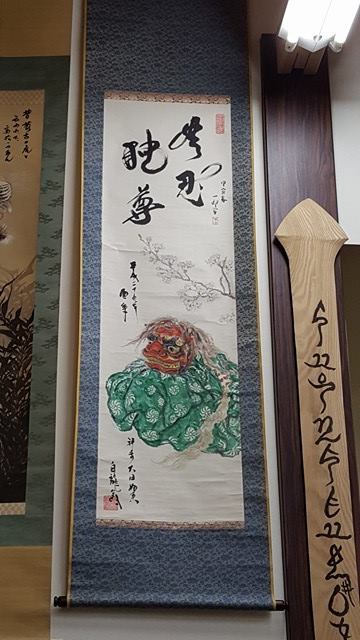
Kannin Dokuson, the new theme for 2017 is only about “respect”.
After Sensei’s explanation, I see it as a Sanshin:
Each movement should include those three aspects. But what does “Respect” really mean?
Everyone uses the word, but how many are aware of its complex meanings and implications? The infinitive “Respicere” gives “Respectus” in Latin, it is used a lot, and convey many interesting conceptual schemes that we are going to review.
Respect comes from Latin. When I was studying Latin more than thirty years ago (sic), the word was used a lot. Respect is one of the first 1000 words used the most. It derives from the infinitive “Respicere” and gives “Respectus”.
The word conveys some interesting conceptual schemes that shed light on its depth. “Respectus” means “to care for”, “to provide for”, “to consider”, “to gaze at”.
The actual meaning of Respectus is “to look back at”, this is the original sense and “Respect” in modern language, is the noun deriving from the verb. (1)
I understand it as “assuming” or “holding the position”. Therefore, it allows you to “look back at” your actions, and to learn. That is the self-respect taught by sensei. And this is the original sense.
Now, if you pay attention to the five meanings above, “Respectus” is a verb and not a noun. And “Respect” in modern language, is the noun deriving from the verb. This noun for me has two main interpretations: esteem and deference. Both convey this idea of mutual respect, and of respecting the enemy. (2)
The Japanese use the noun “Sonkei” (3) and my favourite interpretation is “exalted respect”. Exalted gives the same understanding of superiority, esteem, and deference. Both the Japanese and the Latin languages understand the noun as Omote -the enemy, and Ura -myself. When Omote and Ura are one, then “mutual respect” -inyō, is achieved.
As a practitioner, respect your training and respect your partner, this is for your mutual benefit. This way, your practice will bring you more. Remember training Budō is training for your Life. Persevere, and you will succeed.
Kannin Dokuson (4)
reminder: Kan (貴) and Son (尊) have the exact same meaning
__________________
respect = noun
2.1. a feeling of deep admiration for someone or something elicited by their abilities, qualities, or achievements. “the director had a lot of respect for Douglas as an actor.”
synonyms: esteem, regard, high regard, high opinion, acclaim, admiration, approbation, approval, appreciation, estimation, favour, popularity, recognition, veneration, awe, reverence, deference, honour, praise, homage. “the respect due to a great artist.”
2.2. due regard for the feelings, wishes, or rights of others. “young people’s lack of respect for their parents.”
synonyms: due regard, consideration, thoughtfulness, attentiveness, politeness, courtesy, civility, deference. “he speaks to the old lady with respect.”
From Budoshop by BUDOSHOP.SE
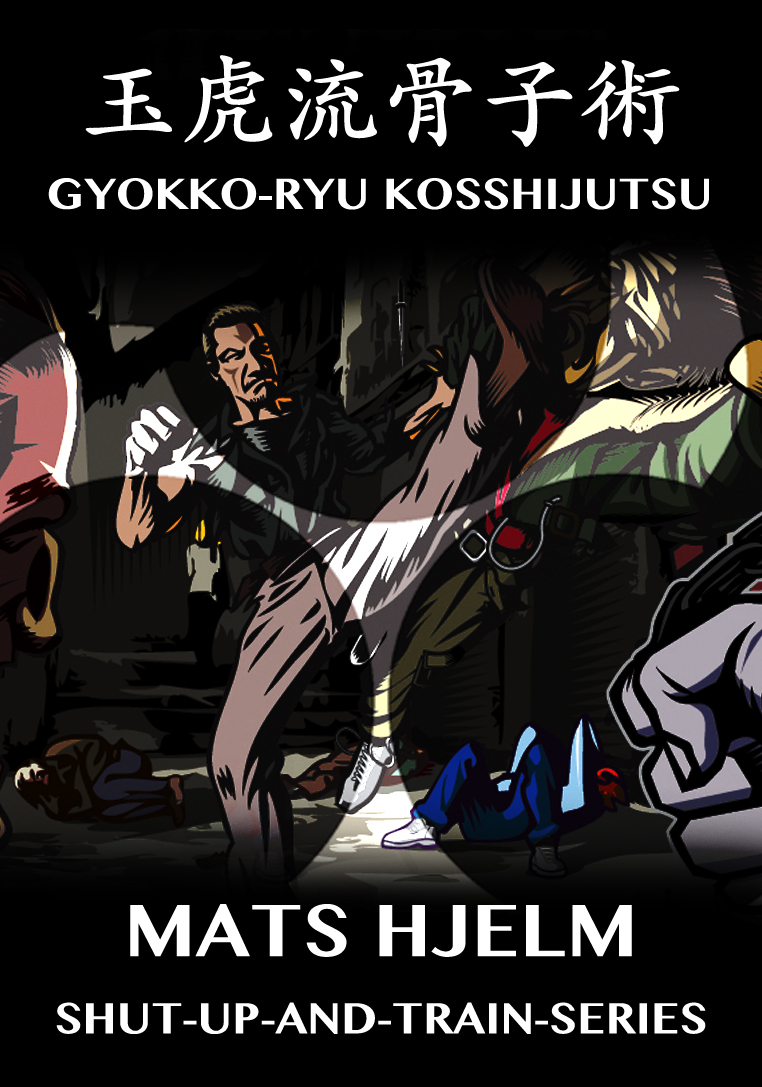
All 51 Gyokko-ryu techniques on 4 files in HD quality, total playing time is 48 minutes. 2.3 Gb (H.264, AAC, 1280x720p)
This was filmed at the Bujinkan Kaigozan Dojo during the late fall of 2016 and early 2017. The theme was Gyokko-ryu Kosshijutsu.
There is no verbal instructions on this film. Each technique is demonstrated several times from all angles. For more information about this ryu-ha click here! Please notice there is several sub-pages to this page with more information, also including an errata for the Densho book published by Hatsumi Soke.
Techniques is demonstrated from several angles including slowmotion speed. There is no verbal instructions, we highly suggest you get the Unarmed Fighting Techniques of the Samurai book (what I call the Densho Book by Hatsumi Soke). This book have all Taijutsu techniques from all the Bujinkan ryu-ha described, it is a must have for all studying the Bujinkan arts.
玉虎流 骨指術
GYOKKŌ-RYŪ KOSSHIJUTSU
0. 基本型 KIHON KATA (23 techniques) Duration: 11:03 min / 597,7 MB on disk
1. 上略の巻 JŌ RYAKU NO MAKI (12 techniques) Duration: 13:36 min / 703 MB on disk
2. 中略の巻 CHŪ RYAKU NO MAKI (8 techniques) Duration: 13:55 min / 720 MB on disk
3. 下略の巻 GE RYAKU NO MAKI (8 techniques) Duration: 09:41 min / 303,6 MB on disk
Each file contains chapter markers for all the techniques for easy skipping to the technique you want to study. You can import the files to your iTunes library and sync it to your iPhone or iPad, or stream to the AppleTV. You can import it to any other library that supports the mp4 format and put it on your Android phone or tablet. Or you can play it directly from your hard drive, streaming to your TV etc.
Title: Complete Gyokko-ryu Kosshijutsu with Mats Hjelm
Instructors: Mats Hjelm
Theme: Gyokko-ryu Kosshijutsu Kihon kata, Jo Ryaku, Chu Ryaku, Ge Ryaku
Recorded: Recorded in Kaigozan Dojo, Stockholm February 2017
Kind: Apple MPEG-4 movie
Size: 2,3 GB on disk
Dimensions: 1280×720
Codecs: 3GPP Text, H.264, AAC, Photo – JPEG
Duration: 48 min…
From Bujinkan Santa Monica by Michael
 |
| 高木 Takagi. photo by Michael Glenn |
From Bujinkan Santa Monica by Michael
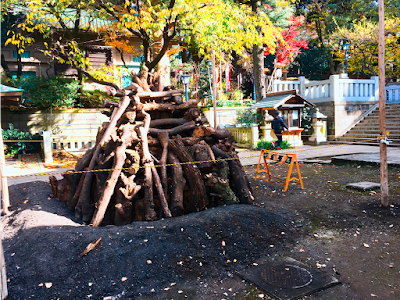 |
| 五條天神社で、お焚き上げ otakiage preparations at Gojoten jinja. photo Michael Glenn |
“This is a way to control. You’ve got to be a shadow. He won’t believe that I’m avoiding.“The next day I ran some errands in Tokyo. The local shrines were already beginning their new year’s preparations. I stopped and stared at a pile of wood that was made ready for the お焚き上げ otakiage bonfire. Fire can purify and burn away problems from the previous year.
“This muto dori feeling is very important. One finger. Just kind of pass by. This way of moving through the kukan is important.”What Hatsumi Sensei was teaching was how to control. I discovered much later that this type of control arises neither by evading or NOT evading. It is hidden in between.
“You control him like this. This is the theme. Connect these ideas. It becomes zero. Connecting zero.”You can find the middle way between evading and not evading by merging with this universal space (Hatsumi Sensei said shizento and uchuuto). Then he called it a 玉 gyoku or egg ( I don’t know what that means, but if you do, please contact me).
“This is the idea of freedom. This is the strength of freedom. The power of freedom. Because it's very wide, it's very vast (宇宙 uchuu). You want to go up into space.”The flames from the bonfire rise above the shrine, sending sparks past the 鳥居 torii, and up among the stars. I would burn with them. There I learn the freedom of this distance.
From Kasumi An Study Center 霞庵 スタディセンター by カスミアン
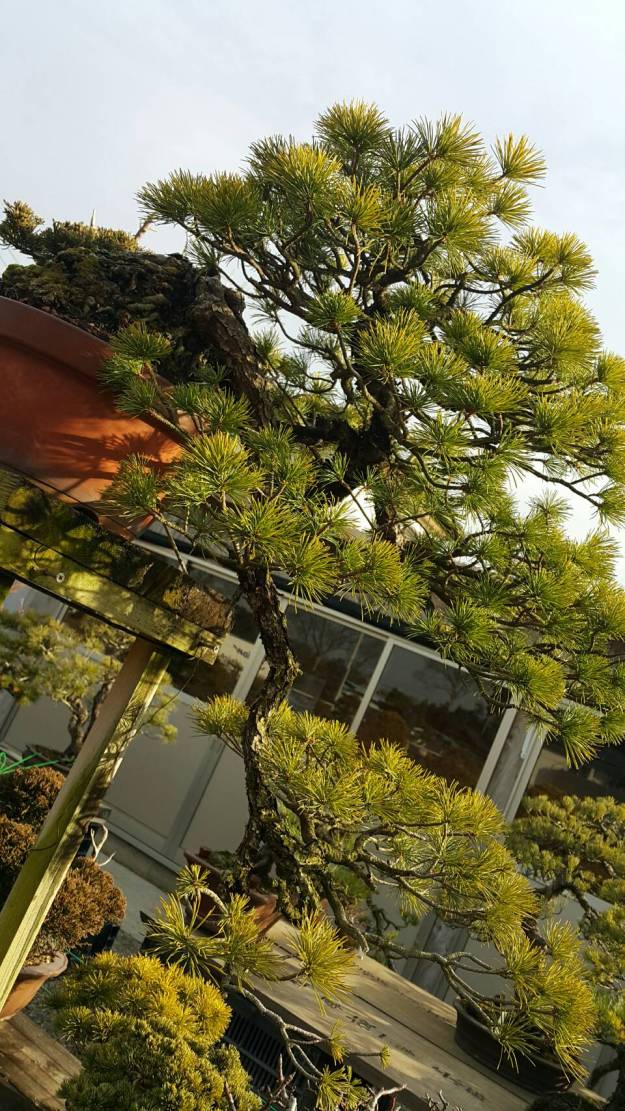 Over the last twenty three years here in Japan, I often have the pleasure and honor to translate for my teacher Masaaki Hatsumi Soke. Often a student has a question that he would like to ask. It is a always a delight to be able to help facilitate communication between teacher and student. So many questions and so many unexpected answers! One episode comes to mind.
Over the last twenty three years here in Japan, I often have the pleasure and honor to translate for my teacher Masaaki Hatsumi Soke. Often a student has a question that he would like to ask. It is a always a delight to be able to help facilitate communication between teacher and student. So many questions and so many unexpected answers! One episode comes to mind.
A student asks, “Why are some people friendly to your face but then are hurtful and mean behind your back?”.
Sensei replies nonchalantly, “that is just how people are made.”. As I translate, I can see the look of confusion cross the students` faces. I too am at a bit of a loss. So the question is asked again and once again the answer is the same,”that is just how people are made.”. Then Sensei looks up into space and asks me, “Paul, have you ever seen a bonsai?”. (small miniature Japanese art trees)I nod my head “yes”. In fact, I had just taken some friends to a bonsai garden the day before so I was a bit surprised by the sudden question about bonsai. He continues, “it is like a bonsai, people are made. You can make a person any way. But it is not natural. You would not go to a forest and find a bonsai. It is not a natural state. But you can twist a bonsai into any shape you want. People are the same.”
How true! Just the prior day I was remarking on the branches of the bonsai. Each branch wrapped with wire and forced to go this way or that way. Every branch! 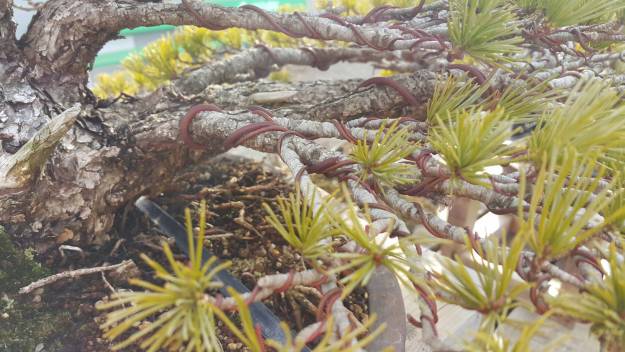 Each branch wrapped in wire and forced to take a seemingly natural posture or kamae. And how unnatural it really is. We, too, as humans, each being wrapped in the culture, politics, education, religions and beliefs of those around us and society. Some people wrapped as capitalists, some marxists, some Christians, some Muslim. But all are being bound by the conditioning of the environment and society. Then what you think are your own thoughts can betray you. In a tragic conclusion, we often we take a kamae or stance for or against another wrapped up in a different shape. Both unaware of the wires that trap them in this position.
Each branch wrapped in wire and forced to take a seemingly natural posture or kamae. And how unnatural it really is. We, too, as humans, each being wrapped in the culture, politics, education, religions and beliefs of those around us and society. Some people wrapped as capitalists, some marxists, some Christians, some Muslim. But all are being bound by the conditioning of the environment and society. Then what you think are your own thoughts can betray you. In a tragic conclusion, we often we take a kamae or stance for or against another wrapped up in a different shape. Both unaware of the wires that trap them in this position.
Unwrapping these wires and constraints is an important step in the practice of Ninjustu. A true ninja will become free and his tree will grow strong and pure into a natural state in accordance with the natural state of his existence. A Ninja is able to explore his true essence in infinite space. That is why in the Go Jou or Five Precepts as taught by my teacher, a constant diligence and watchfulness to your true path is essential. First become aware of where you are now. What shape are you now? When your shape become visible, start unwrapping!…
From Kasumi An Study Center 霞庵 スタディセンター by Kasumi An Study Center
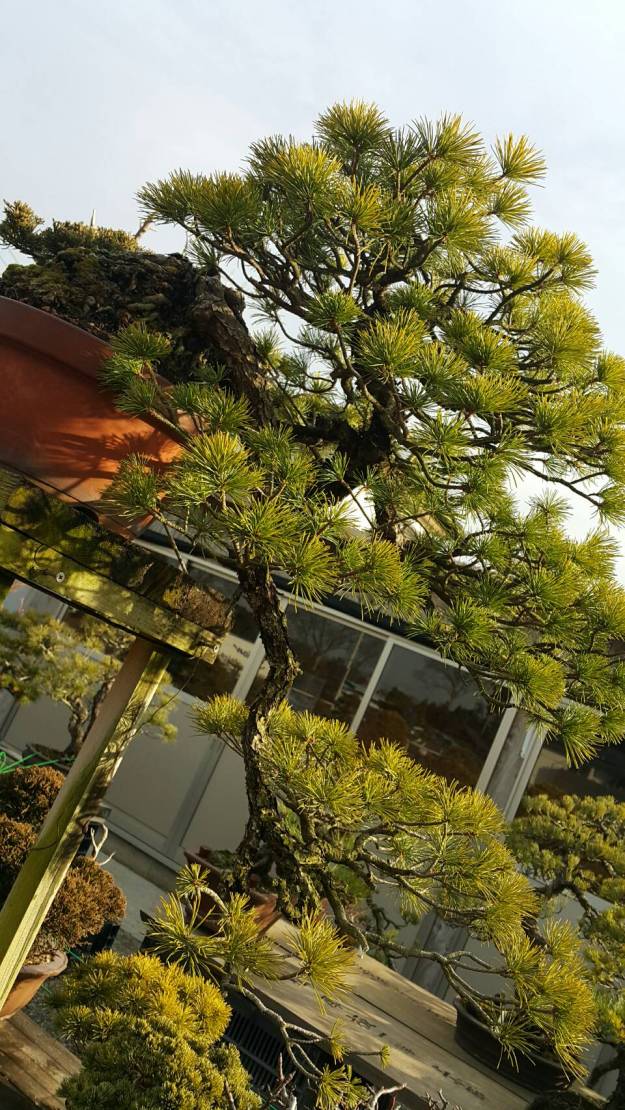 Over the last twenty three years here in Japan, I often have the pleasure and honor to translate for my teacher Masaaki Hatsumi Soke. Often a student has a question that he would like to ask. It is a always a delight to be able to help facilitate communication between teacher and student. So many questions and so many unexpected answers! One episode comes to mind.
Over the last twenty three years here in Japan, I often have the pleasure and honor to translate for my teacher Masaaki Hatsumi Soke. Often a student has a question that he would like to ask. It is a always a delight to be able to help facilitate communication between teacher and student. So many questions and so many unexpected answers! One episode comes to mind.
A student asks, “Why are some people friendly to your face but then are hurtful and mean behind your back?”.
Sensei replies nonchalantly, “that is just how people are made.”. As I translate, I can see the look of confusion cross the students` faces. I too am at a bit of a loss. So the question is asked again and once again the answer is the same,”that is just how people are made.”. Then Sensei looks up into space and asks me, “Paul, have you ever seen a bonsai?”. (small miniature Japanese art trees)I nod my head “yes”. In fact, I had just taken some friends to a bonsai garden the day before so I was a bit surprised by the sudden question about bonsai. He continues, “it is like a bonsai, people are made. You can make a person any way. But it is not natural. You would not go to a forest and find a bonsai. It is not a natural state. But you can twist a bonsai into any shape you want. People are the same.”
How true! Just the prior day I was remarking on the branches of the bonsai. Each branch wrapped with wire and forced to go this way or that way. Every branch!  Each branch wrapped in wire and forced to take a seemingly natural posture or kamae. And how unnatural it really is. We, too, as humans, each being wrapped in the culture, politics, education, religions and beliefs of those around us and society. Some people wrapped as capitalists, some marxists, some Christians, some Muslim. But all are being bound by the conditioning of the environment and society. Then what you think are your own thoughts can betray you. In a tragic conclusion, we often we take a kamae or stance for or against another wrapped up in a different shape. Both unaware of the wires that trap them in this position.
Each branch wrapped in wire and forced to take a seemingly natural posture or kamae. And how unnatural it really is. We, too, as humans, each being wrapped in the culture, politics, education, religions and beliefs of those around us and society. Some people wrapped as capitalists, some marxists, some Christians, some Muslim. But all are being bound by the conditioning of the environment and society. Then what you think are your own thoughts can betray you. In a tragic conclusion, we often we take a kamae or stance for or against another wrapped up in a different shape. Both unaware of the wires that trap them in this position.
Unwrapping these wires and constraints is an important step in the practice of Ninjustu. A true ninja will become free and his tree will grow strong and pure into a natural state in accordance with the natural state of his existence. A Ninja is able to explore his true essence in infinite space. That is why in the Go Jou or Five Precepts as taught by my teacher, a constant diligence and watchfulness to your true path is essential. First become aware of where you are now. What shape are you now? When your shape become visible, start unwrapping!
From Kasumi An Study Center 霞庵 スタディセンター by カスミアン
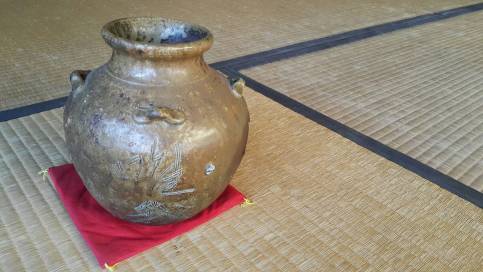
Artist: Paul Masse 2007. Inscription: 天上天下唯我独
“In the all the heavens and earth, only I am exalted!”
Kan Nin Dock Son is a phrase you may hear around the Bujinkan dojo this year. Is it the theme for the year? Maybe, maybe not. Who knows?! But whether it is a theme or not is really not important, it should give you something to ponder and explore this year in addition to your continued practice of the physical movement and techniques. Kan Nin 貫忍, steadfast and single-minded perseverance all the way. Doku Son 独尊、to be revered or exalted. It most likely refers to a story of the Buddha. The story is, when he was born, the Buddha took seven steps and pointed one finger up and one finger down and exclaimed, “In the all the heavens and earth, only I am exalted!”. What is this elusive I? Some think of it as me, my name, age ect. But you would lose some of the poetry. Who are you when your name, age, social status are stripped away. Going deeper, who are you when the body is stripped away and the mind faded and gone, and even your conscience vanishes like smoke after a fire?Maybe you have heard the Gokui (inner teachings) Persevere the body, Persevere the heart, and Persevere the conscience.
Your body had plopped out of this earth and it will dissolve back into the earth. No matter how good they wrap you like a mummy! But what of a natural energy? A power of nature that drives the seasons, sings thru a myriad of creatures? This power that keeps the clouds drifting and the water flowing, and an infinite number of stars alight? This natural power, the natural power of life is what we must become aware. When you have persevered thru all, this power will shine. Hatsumi Sensei once said to me, “it is like in the movies, when someone opens a treasure box, and their face is lit up by the golden light of the treasure.”. I really like this image. This is the treasure of Nin or Ninpo, 忍宝。 Kan Nin will help to uncover it. Be like Indiana Jones and go treasure hunting. The treasure is so near! When you uncover it, you won’t need to be and air bender or water bender or fire bender. You will know that you have been bending them all the time!…